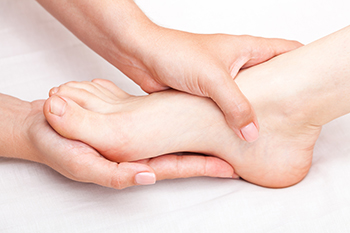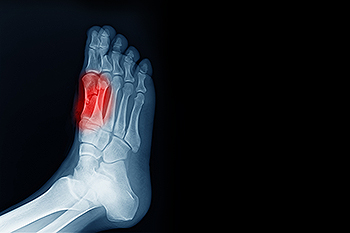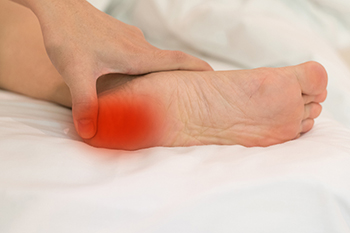Connect With Us
Blog
Items filtered by date: July 2022
How to Manage Pain From a Plantar Fibroma

A bump on the bottom of the foot may be indicative of a foot condition known as plantar fibromatosis. This ailment develops on the plantar fascia which is the band of tissue that runs along the bottom of the foot. Its function is to connect the heel to the toes, in addition to supporting the arch. A plantar fibroma can form when nodules grow in the plantar fascia, and can cause pain and discomfort. Research has shown there is no cure for this condition, and existing patients often look to manage the pain. This can be done by performing specific foot stretches that can help to strengthen the foot. A calf stretch is effective in relieving pain from the plantar fascia, and this is done by standing on a step, and lowering the heel until a gentle stretch is felt. Patients may find that performing a marble pick up is helpful in strengthening the arch. This is a simple stretch, and may take some practice to perfect it. This is done by placing several marbles on the floor next to a towel, and picking one marble up at a time with your foot. If you would like more information about how to relieve pain from a plantar fibroma, please consult with a podiatrist.
A plantar fibroma may disrupt your daily activities. If you have any concerns, contact Vivian C. Iwu, DPM of Choice Podiatry Center. Our doctor can provide the care you need to keep you pain-free and on your feet.
Plantar Fibroma
A plantar fibroma is a fibrous knot in the arch of the foot. It is embedded in the plantar fascia which is a band of tissue that extends from the heel to the toes along the bottom of the foot. There can be multiple plantar fibromas in the feet at the same time. There are no known causes for this condition. If you have a plantar fibroma, there will be a bump in the arch of your foot that cannot be missed. Any associated pain is most often due to a shoe rubbing against the nodule. Non-surgical options, such as steroid injections, physical therapy, and orthotics should be tried first. Surgery is a last resort and is the only thing that will remove a plantar fibroma entirely. Consult with a podiatrist for a proper diagnosis and to determine the treatment regimen that is right for you.
What Causes a Plantar Fibroma?
While there are no specific causes identified, a plantar fibroma can possibly come from genetic predisposition or the formation of scar tissue that forms from healing the tears in the plantar fascia.
What Are the Symptoms of a Plantar Fibroma?
There will be a noticeable lump in the arch of the foot that may or may not cause pain. If pain is felt, it is typically because a shoe is rubbing up against the lump or when walking or standing barefoot.
Treatment and Prevention
A plantar fibroma will not disappear without treatment, but it can get smaller and be a non-issue. If pain persists, a podiatrist examines the foot and when the arch of the foot is pressed, pain can be felt down to the toes. An MRI or biopsy might be performed to help diagnose or evaluate the plantar fibroma. The following non-surgical options are generally enough to reduce the size and pain of these nodules:
- Steroid injections
- Orthotics
- Physical therapy to help apply anti-inflammatory creams on the bump
Surgery is considered if the mass increases in size and the patient continues to feel pain after non-surgical methods are tried.
If you have any questions please feel free to contact our office located in Marietta, GA . We offer the newest diagnostic tools and technology to treat your foot and ankle needs.
It's Time for Beautiful Feet
All About Podiatrists

Feet are a critical yet often overlooked component of one’s health. Podiatrists are medical professionals who specialize in maintaining proper foot health. These experts focus solely on the feet, ankles, and other lower limbs. Podiatrists can address a variety of different kinds of afflictions affecting the feet. For example, a podiatrist can help you treat or prevent conditions such as plantar warts, plantar fasciitis, corns, bunions, stress fractures, athlete’s foot, and ingrown toenails. If you are pregnant, elderly, or suffering from diabetes, you might be particularly vulnerable to suffering from foot afflictions, and you could stand to benefit from contacting a podiatrist. Before visiting the podiatrist, you might plan on bringing the pair of shoes with you that you typically wear everyday. This will help a podiatrist get a sense of how the footwear that you usually wear affects the health of your feet. Some podiatrists will also encourage the patient to come to their first visit with specific questions about their feet and anything unusual that they are experiencing. Podiatrists are undoubtedly valuable medical professionals that may be able to help you maintain healthy feet.
If you are experiencing pain in the feet or ankles, don’t join the stubborn majority refusing treatment. Feel free to contact Vivian C. Iwu, DPM from Choice Podiatry Center. Our doctor can provide the care you need to keep you pain-free and on your feet.
What Is a Podiatrist?
Someone would seek the care of a podiatrist if they have suffered a foot injury or have common foot ailments such as heal spurs, bunions, arch problems, deformities, ingrown toenails, corns, foot and ankle problems, etc.
Podiatric Treatment
A podiatrist will treat the problematic areas of the feet, ankle or lower leg by prescribing the following:
- Physical therapy
- Drugs
- Orthotic inserts or soles
- Surgery on lower extremity fractures
A common podiatric procedure a podiatrist will use is a scanner or force plate which will allow the podiatrist to know the designs of orthotics. Patients are then told to follow a series of tasks to complete the treatment. The computer will scan the foot a see which areas show weight distribution and pressure points. The podiatrist will read the analysis and then determine which treatment plans are available.
If you have any questions please feel free to contact our office located in Marietta, GA . We offer the newest diagnostic and treatment technologies for all your foot and ankle needs.
How is Sesamoiditis Diagnosed?

An injury can lead to the foot condition known as sesamoiditis. This can happen as a result of a sporting mishap, which can affect the sesamoid bones that are found inside a tendon or muscle. The sesamoid bones aid with shock absorption, and help in balancing while walking or running. Common symptoms that people can experience with this foot condition can include a dull pain in the bottom or ball of the foot, and they may feel a sensation of stepping on marbles or small pebbles. Bruising and swelling can develop at the site of the injury, and the affected area may be tender to touch. X-rays can aid in the diagnosis of sesadmoiditis, as well as an MRI, which can provide additional pictures of the tissues and tendons surrounding the sesamoid bones. Patients who have sesamoiditis may find relief when supportive shoes are worn, and specific exercises are practiced. This is a condition that is treated by a podiatrist, and it is advised that you schedule an appointment with this type of doctor if you are affected by this ailment.
Sesamoiditis is an unpleasant foot condition characterized by pain in the balls of the feet. If you think you’re struggling with sesamoiditis, contact Vivian C. Iwu, DPM of Choice Podiatry Center. Our doctor will treat your condition thoroughly and effectively.
Sesamoiditis
Sesamoiditis is a condition of the foot that affects the ball of the foot. It is more common in younger people than it is in older people. It can also occur with people who have begun a new exercise program, since their bodies are adjusting to the new physical regimen. Pain may also be caused by the inflammation of tendons surrounding the bones. It is important to seek treatment in its early stages because if you ignore the pain, this condition can lead to more serious problems such as severe irritation and bone fractures.
Causes of Sesamoiditis
- Sudden increase in activity
- Increase in physically strenuous movement without a proper warm up or build up
- Foot structure: those who have smaller, bonier feet or those with a high arch may be more susceptible
Treatment for sesamoiditis is non-invasive and simple. Doctors may recommend a strict rest period where the patient forgoes most physical activity. This will help give the patient time to heal their feet through limited activity. For serious cases, it is best to speak with your doctor to determine a treatment option that will help your specific needs.
If you have any questions please feel free to contact our office located in Marietta, GA . We offer the newest diagnostic and treatment technologies for all your foot and ankle needs.
Could Corticosteroid Injections Help My Heel Pain?

Heel pain is a common complaint among many patients visiting a podiatrist. Although there are several possible causes of this heel pain, plantar fasciitis is the likeliest. Plantar fasciitis is an inflammation of the plantar fascia tissue on the sole of the foot. This tissue connects the heel with the forefoot and can suffer damage from overuse, complications due to abnormal foot structure, improper footwear, and more. Plantar fasciitis can affect all people from athletes to ordinary people leading fairly sedentary lives. Older or obese individuals, those who stand while working, or who have flat feet or a shortened Achilles tendon, have a higher risk of developing plantar fasciitis. There are many treatment modalities that your podiatrist may discuss with you if it's determined that plantar fasciitis is the cause of your heel pain. If it's chronic and does not respond to more conservative treatments, your podiatrist may suggest corticosteroid injections. This type of anti-inflammatory medicinal treatment is believed to help reduce pain and inflammation in many patients. If you are suffering from heel pain, have a podiatrist examine you. If you are diagnosed with plantar fasciitis, consider all of the treatment options your podiatrist suggests and ask for information about whether corticosteroid injections might be right for you.
Plantar fasciitis can be very painful and inconvenient. If you are experiencing heel pain or symptoms of plantar fasciitis, contact Vivian C. Iwu, DPM from Choice Podiatry Center. Our doctor can provide the care you need to keep you pain-free and on your feet.
What Is Plantar Fasciitis?
Plantar fasciitis is the inflammation of the thick band of tissue that runs along the bottom of your foot, known as the plantar fascia, and causes mild to severe heel pain.
What Causes Plantar Fasciitis?
- Excessive running
- Non-supportive shoes
- Overpronation
- Repeated stretching and tearing of the plantar fascia
How Can It Be Treated?
- Conservative measures – anti-inflammatories, ice packs, stretching exercises, physical therapy, orthotic devices
- Shockwave therapy – sound waves are sent to the affected area to facilitate healing and are usually used for chronic cases of plantar fasciitis
- Surgery – usually only used as a last resort when all else fails. The plantar fascia can be surgically detached from the heel
While very treatable, plantar fasciitis is definitely not something that should be ignored. Especially in severe cases, speaking to your doctor right away is highly recommended to avoid complications and severe heel pain. Your podiatrist can work with you to provide the appropriate treatment options tailored to your condition.
If you have any questions please feel free to contact our office located in Marietta, GA . We offer the newest diagnostic and treatment technologies for all your foot and ankle needs.


